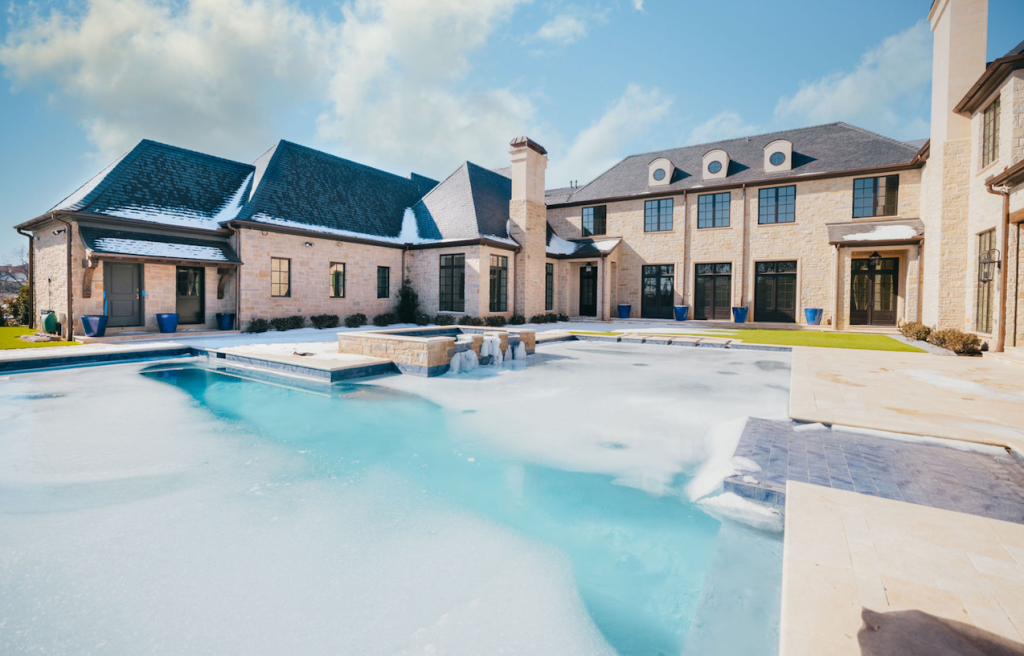Maintaining Your Pool After Freezing Conditions
It’s that time of year again when the outdoor temperature will begin to swan dive right on down to freezing or below-freezing levels. While it’s still certainly possible to keep your pool up and running during these colder months, extra care needs to be taken to prepare your pool both during and after a hard freeze to avoid costly damage to the pool and its components.

Follow Proper Pool Care Procedures
Are wintery conditions in the upcoming forecast? There are many things you can do to prepare your pool for the frigid temperatures ahead.
- Make sure the water is balanced.
- Check your skimmer and pump baskets. Clean them if necessary.
- If the pool won’t be in use, remove all unnecessary equipment from the pool.
- If snow is in the forecast, place a tarp over your equipment. It should be high enough for you to place a drop light beneath it (the light will add warmth), though be sure the drop light is placed far away from any plastic components, pipes, and combustible material.
For Pools That Are Still Running During a Freeze
Moving water can’t freeze, so the first step is to make sure your filtration and auxiliary pool pumps are running continuously. Many pumps have a built-in freeze guard that will automatically kick into action once the outside air reaches a certain temperature.
You can test your freeze guard by using plastic tongs to place an ice cube inside or next to its copper coil. If working correctly, the freeze guard should start your pool pump within 5 minutes.
It’s important to remember that you don’t need to run your heater to prevent your pool water from freezing. In fact, running your heater in freezing conditions can cause substantial damage to the unit.
If your pool has ice on its surface, break it up so that the skimmers and skimmer doors are kept clear. The skimmer doors can be removed if it’s not possible to keep ice out of the way. Adjusting the jets in your pool upwards and using swimming pool antifreeze will also help put a stop to any surface freezing.
Maintaining proper pool chemistry and water levels is crucial during the cooler months of the year. By keeping your water in the middle of the tile line, you’re preventing your pumps from drawing damaging cold air in through the skimmers.
It’s also a good idea to cover your pool when it’s not in use. A sturdy pool cover will both keep debris out of your water and maintain a higher pool water temperature, reducing the risk of the water freezing.
For Pools That Aren’t Running or Lose Power During a Freeze
If you experience a loss of power, start off by turning off all circuit breakers leading to your pool equipment. Then head out to the pool and open up the filter air bleed valve (you can use warm water to dislodge any ice that may be in the way).
Remove all drain plugs from the bottom of your pool pump and the drain filter, and take off all winterizing plugs/open drain valves to remove any excess water (you can place the plugs in the pump basket) and then loosely replace the lid. Adjust your valves to their middle positions as this will allow your pool water to flow back into the pool.
If you have any pipes that can’t be drained, it’s a good idea to protect those pipes with electrical heat strips, which can be found at a local hardware store. Pools with electronic ignition heaters should be covered with a blanket for an added layer of insulation. When you cover your pool with a sturdy cover, it should be well protected from freezing.
What to Do When Warm Weather Returns
All of your efforts in maintaining your pool during cooler weather will certainly pay off when the warm weather returns! As you’ll find, well-cared-for pools during the winter require minimum effort when hotter days make their much-welcomed comeback.
Start by removing dirt and debris from your pool cover and the surrounding area. Check your pool’s water levels and use your garden hose to top it off if necessary. Replace all plugs and lids, rebalance your water, and run your pump for at least 24 hours and your pool should be ready to use and enjoy once more.
Your Fort Worth Pool Service Experts
While freezing conditions have the possibility to wreak havoc on the health of your pool, properly taking care of your pool post-weather will help you keep your pool in the best condition. Give the pool service experts at Pulliam Pools a call today with any questions you may have after the freeze or to schedule your professional pool service appointment.




